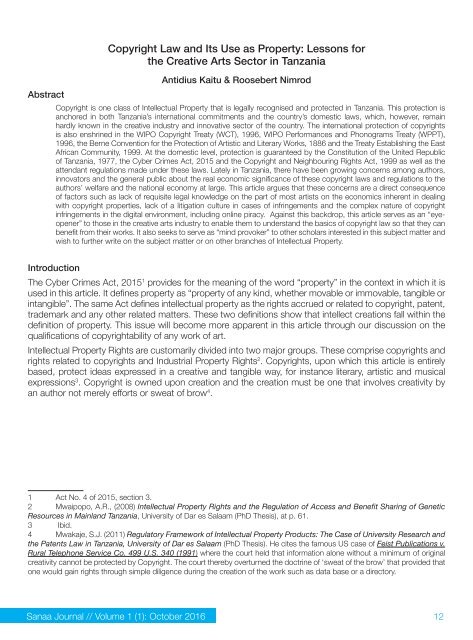African Arts Media Cultures
SanaaJournalIssue1Vol.1
SanaaJournalIssue1Vol.1
Create successful ePaper yourself
Turn your PDF publications into a flip-book with our unique Google optimized e-Paper software.
Abstract<br />
Copyright Law and Its Use as Property: Lessons for<br />
the Creative <strong>Arts</strong> Sector in Tanzania<br />
Antidius Kaitu & Roosebert Nimrod<br />
Copyright is one class of Intellectual Property that is legally recognised and protected in Tanzania. This protection is<br />
anchored in both Tanzania’s international commitments and the country’s domestic laws, which, however, remain<br />
hardly known in the creative industry and innovative sector of the country. The international protection of copyrights<br />
is also enshrined in the WIPO Copyright Treaty (WCT), 1996, WIPO Performances and Phonograms Treaty (WPPT),<br />
1996, the Berne Convention for the Protection of Artistic and Literary Works, 1886 and the Treaty Establishing the East<br />
<strong>African</strong> Community, 1999. At the domestic level, protection is guaranteed by the Constitution of the United Republic<br />
of Tanzania, 1977, the Cyber Crimes Act, 2015 and the Copyright and Neighbouring Rights Act, 1999 as well as the<br />
attendant regulations made under these laws. Lately in Tanzania, there have been growing concerns among authors,<br />
innovators and the general public about the real economic significance of these copyright laws and regulations to the<br />
authors’ welfare and the national economy at large. This article argues that these concerns are a direct consequence<br />
of factors such as lack of requisite legal knowledge on the part of most artists on the economics inherent in dealing<br />
with copyright properties, lack of a litigation culture in cases of infringements and the complex nature of copyright<br />
infringements in the digital environment, including online piracy. Against this backdrop, this article serves as an “eyeopener”<br />
to those in the creative arts industry to enable them to understand the basics of copyright law so that they can<br />
benefit from their works. It also seeks to serve as “mind provoker” to other scholars interested in this subject matter and<br />
wish to further write on the subject matter or on other branches of Intellectual Property.<br />
Introduction<br />
The Cyber Crimes Act, 2015 1 provides for the meaning of the word “property” in the context in which it is<br />
used in this article. It defines property as “property of any kind, whether movable or immovable, tangible or<br />
intangible”. The same Act defines intellectual property as the rights accrued or related to copyright, patent,<br />
trademark and any other related matters. These two definitions show that intellect creations fall within the<br />
definition of property. This issue will become more apparent in this article through our discussion on the<br />
qualifications of copyrightability of any work of art.<br />
Intellectual Property Rights are customarily divided into two major groups. These comprise copyrights and<br />
rights related to copyrights and Industrial Property Rights 2 . Copyrights, upon which this article is entirely<br />
based, protect ideas expressed in a creative and tangible way, for instance literary, artistic and musical<br />
expressions 3 . Copyright is owned upon creation and the creation must be one that involves creativity by<br />
an author not merely efforts or sweat of brow 4 .<br />
1 Act No. 4 of 2015, section 3.<br />
2 Mwaipopo, A.R., (2008) Intellectual Property Rights and the Regulation of Access and Benefit Sharing of Genetic<br />
Resources in Mainland Tanzania, University of Dar es Salaam (PhD Thesis), at p. 61.<br />
3 Ibid.<br />
4 Mwakaje, S.J. (2011) Regulatory Framework of Intellectual Property Products: The Case of University Research and<br />
the Patents Law in Tanzania, University of Dar es Salaam (PhD Thesis). He cites the famous US case of Feist Publications v.<br />
Rural Telephone Service Co. 499 U.S. 340 (1991) where the court held that information alone without a minimum of original<br />
creativity cannot be protected by Copyright. The court thereby overturned the doctrine of ‘sweat of the brow’ that provided that<br />
one would gain rights through simple diligence during the creation of the work such as data base or a directory.<br />
Sanaa Journal // Volume 1 (1): October 2016<br />
12


